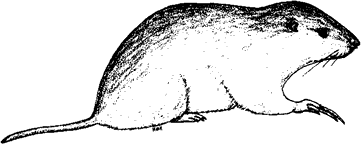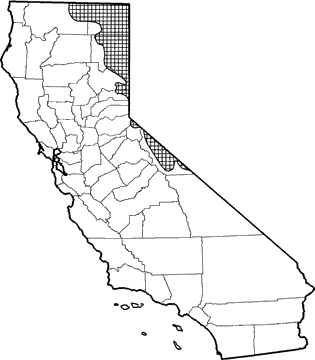
Northern Pocket Gopher
Distribution, Abundance, and Seasonality
In California, the northern pocket gopher occurs from Mono Co. north into Alpine, eastern Sierra, eastern Plumas, Lassen, Modoc, and eastern Siskiyou cos. Abundant in juniper habitats with herbaceous understories, and in annual grassland, perennial grassland, wet meadow, cropland, and montane riparian habitats. Common in open stands of a variety of wooded and brushy habitats.

Range Map
Specific Habitat Requirements
Feeding: Feeds on stems, leaves, and roots of forbs and grasses. The summer diet in Colorado was 90% forbs, of which 75% was stems and leaves and 25% was roots. Some important plants include aspen, fleabane, lupine, gilia, dandelion, cinquefoil, and yarrow (Ward and Keith 1962). Food is stored extensively in underground chambers.
Cover: Burrows in friable soils. Horizontal feeding tunnels usually lie within a few inches of the surface, and lead to lateral tunnels, which terminate at surface mounds (Miller 1964). Most burrowing activity occurs in spring, either in response to moist soil conditions, changes in feeding habits, or reproductive cycles.
Reproduction: A nest of dried vegetation is constructed in an underground nest chamber.
Water: Meets water needs with succulent vegetation.
Pattern: Deep friable soils with moderate cover of grasses and forbs are preferred.
Species Life History
Activity Patterns: Active yearlong. Active throughout the day, but emerges from burrows mainly at night.
Seasonal Movements / Migration: None reported.
Home Range: No data found.
Territory: Territory size and home range roughly equivalent. Adult males are aggressively solitary, but juveniles, females, and males probably share burrow systems during the reproductive season. In Colorado, the average distance to nearest neighbor was 15.8 m (52 ft) (Hansen and Remmenga 1961, Vaughan and Hansen 1964, Hansen and Beck 1968).
Reproduction: Breeds from mid-March to mid-June or July, depending on the area. Gestation period about 28 days (Scheffer 1938). Average litter size varies from 3-6 (Hansen 1960). Usually 1 litter per yr, although in agricultural fields gophers may breed year-round. Breeding probably occurs in the first spring following weaning (Hansen 1960).
Niche: Likely predators include owls, hawks, predatory mammals, and snakes. T. bottae is its closest competitor. T. talpoides has a broader niche in comparison to the more restricted T. bottae (Miller 1964). Burrowing activities aid in mixing of soils and percolation of water. Heavy grazing may reduce numbers.
Sources & References
California Department of Fish and Game, 1999.
California's Wildlife, Sacramento, CA.
Written by: P. Brylski, reviewed by: H. Shellhammer, edited by: R. Duke
Hansen, R. M. 1960. Age and reproductive characters of mountain pocket gophers in Colorado. J. Mammal. 41:323-335. Hansen, R. M., and R. F. Beck. 1968. Habitat of pocket gophers in Cochetopa Creek drainage, Colorado. Am. Midl. Nat. 79:103-117. Hansen, R. M., and E. E. Remmenga. 1961. Nearest neighbor concept applied to pocket gophers populations. Ecology 42:812-814. Miller, R. S. 1964. Ecology and distribution of pocket gophers (Geomyidae) in Colorado. Ecology 45:256-272. Scheffer, T. H. 1938. Breeding records of Pacific Coast pocket gophers. J. Mammal. 19:220-224. Thaeler, C. S., Jr. 1968. An analysis of the distribution of pocket gopher species in northeastern California (Genus Thomomys). Univ. Calif. Publ. Zool. 86:1-46. Vaughan, T. A., and R. M. Hansen. 1964. Experiments on interspecific competition between two species of pocket gophers. Am. Midl. Nat. 72:444-452. Ward, A. C., and J. O. Keith. 1962. Feeding habits of pocket gophers on mountain grasslands. Black Mesa. Colorado Ecology 43:744-749.
California Animal Facts | California's Wildlife